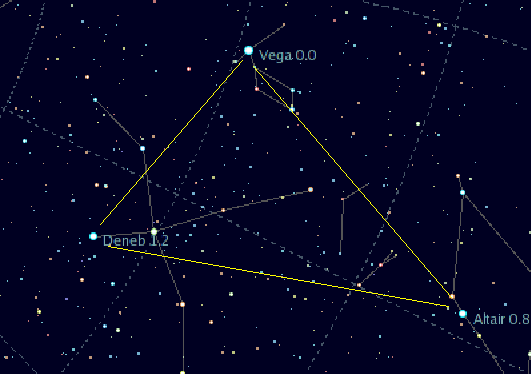 |
| Summer triangle Vega, Deneb, Altair by Jim Thomas. Licensed under GPL via Commons |
Introduction
Even our quick study of some notable objects in the swathe of sky bounded by the borders of the constellation Lyra demonstrates the exponential growth of knowledge about the space achieved by humans. This daily growing information and understanding do pose significant challenges to those adhering to the Judaeo-Christian heritage based upon the Bible.
The impact on faith in the God of Israel is, however, deep and very closely tied to individual believer's familiarity with modern Cosmology and Astronomy. As years go by the scientific information will penetrate deeper to the public consciousness and the questions start to rise. It is safe to assume that currently those twinkling stars and beautiful pictures of galaxies are for great part of humanity rather distant from the general worldview, impractical and curiosity rather then fundamental building blocks of personal world view. There are more pressing things to consider and the science/religion discussions that create excitement among many Christians focus on life sciences, especially evolutionary biology.
Cosmology and Astronomy have deeper impact on Theology than life sciences and can be compared to the rumblings of a massive earthquake under the Church. The following points of Astrotheology are written knowingly as theses without references to other theologians' writings. This independent approach is an invitation to critical discussion and reflection and I plan to introduce at a later point various theological views, particularly from the Roman Catholic church which for centuries has dealt with the issues and has an observatory in Vatican.
The astronomical details mentioned in these theological theses focus on the constellation of Lyra and are discussed previously in this blog under the title Lyra studies written in October-November 2015.
Soli Deo Gloria
Thesis I: Perspective
The challenge
The fifth brightest stars in the night sky is the beautiful Vega in the constellation of Lyra. It is a bluish white main sequence star with spectral class A0V. It is fusing hydrogen to helium like Sun. As it is three times larger than Sun the nuclear reaction happens quickly. The expected life-time is one billion years while astronomers estimate that Sun will shine some 10 billion years. At the age of 455 million years Vega has reached half of its life as an active star.
The visible brightness of Vega is explained by the fact that according to current measurements it is only 25 light years from the Sun. The closest star to us, Alpha Centauri, is at 4.37 light years distance which expressed in another astronomic scale is 1.7 parsecs.
All these measurements of time and distance are mind-boggling. In the beginning of the 20the century humanity did not know about the true scale of the Universe. Improved observation instruments and careful study of star light, discovery of Cepheid variables and the realization that there are other galaxies beyond Milky Way began to reveal the truth.
With the ability to estimate the age and distance of Vega, among other stars, has profoundly changed our view of the world and the place of planet Earth in it.
Theological points
- The 6000 years fallacy
Many Christians who do know something about the advances of Astronomy fail to integrate this knowledge with their faith. A tested and widespread solution is just to ignore the facts and to adhere to the Biblical chronology based on ancient Jewish genealogies. Jews, Christians and Muslims have traditionally held to the creation of Adam about 6000 years ago, so this is when God made everything.
Believing that Vega was made 455 million years ago is blasphemy for these believers. They believe that giving up 6000 years chronology threatens the very foundations of true faith. This approach ties very closely numbers and a specific world view with religious beliefs into a single package and causes, unfortunately, mockery to the name of the God most high.
I have spoken to you of earthly things and you do not believe; how then will you believe if I speak of heavenly things?-Scope of the Bible reduced from Universal to Global
Jesus in Gospel of John 3:12
Within the Judaeo-Christian tradition the growth of knowledge and the following enormous widening of universal dimensions is felt particularly poignantly in the traditional 3-tier world view of Earth here, Heaven above and Hell below as well as in the Eschatological views about the end of the world.
The new perspectives opened to humanity by 20th century scientific research of God's creation force us to delimit the scope of the Bible from Universal to Global. What requires this reassessment is nothing but Truth about Nature as we know it today.
The Bible is geocentric, anthropocentric and christocentric
The humiliation of proud humanity by modern Cosmology is profound - the world created by God is in its glory neither geocentric nor anthropocentric. Evolving Astronomy has shown that Sun is just one middle sized star - actually a dwarf - in one of the billions of galaxies out there with no particular prominence. Tellus is hardly visible even from the nearby Saturn.
If this reduction of the scope of the Bible were the whole story those who abandon the Scriptures while pondering the deepest and most fundamental questions about Universe would be right in doing so. Case closed. But this is not the case. The Scriptures contain more about God, about Christ and about humanity than just an outdated physical model of the Cosmos.
No comments:
Post a Comment